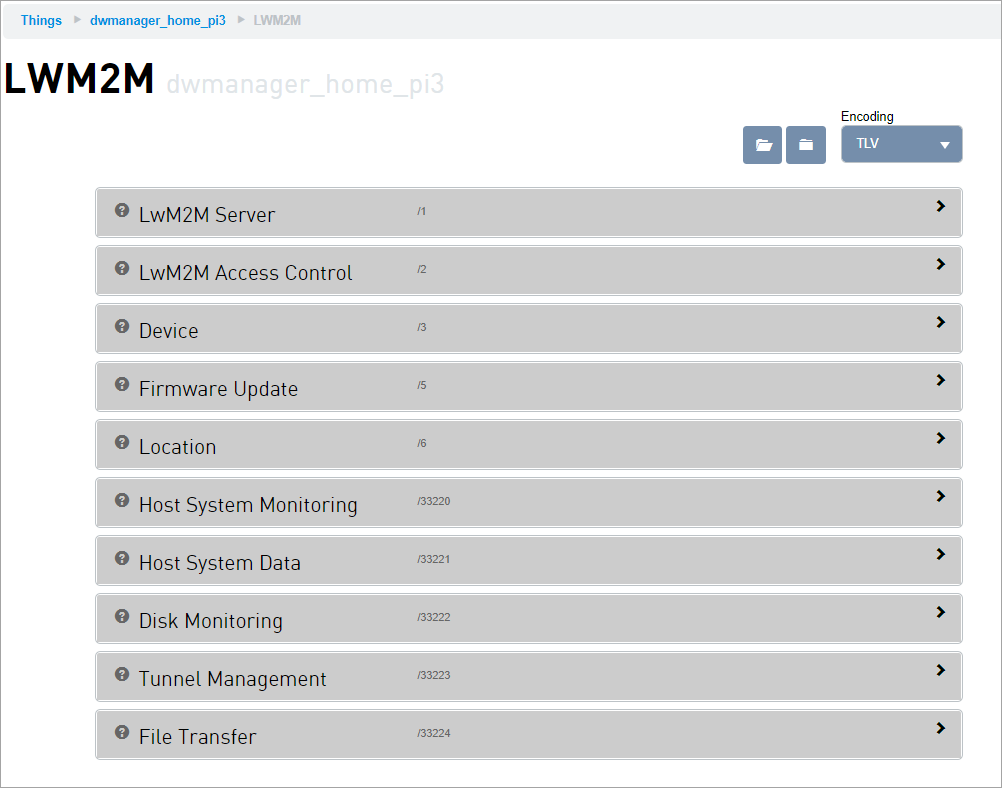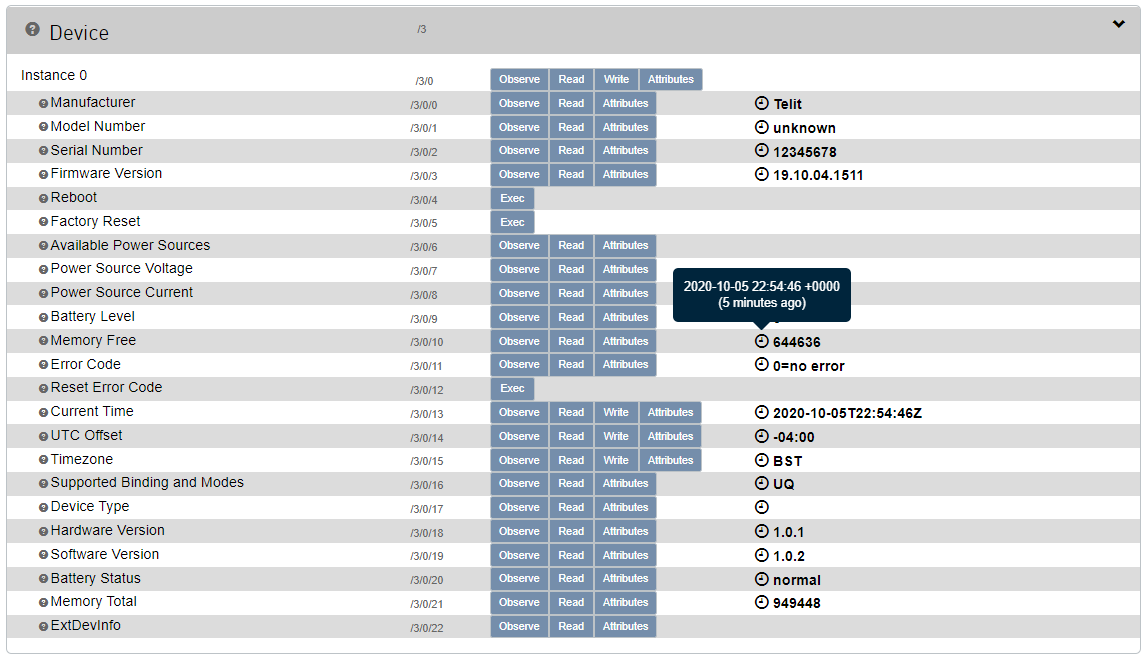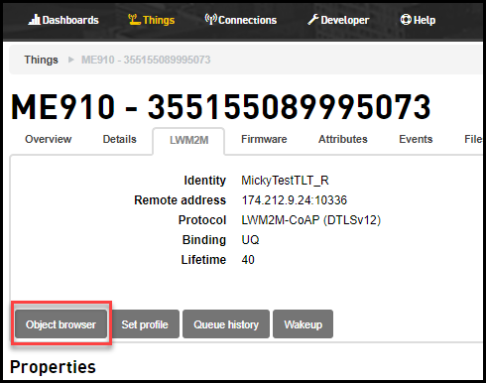The deviceWISE Cloud support the majority of the resources of the LWM2M objects (LwM2M Registry).The Object browser is used to manage the LWM2M objects in a real-time. It lists all the Objects/Instances/Resources that are confined to a LWM2M device as explained in the LWM2M Object model. You will be able to Read/Write/Observe and Update attributes of resources directly from the Object browser.
Clicking the Object browser button in the LWM2M tab will open a window showing all the supported LWM2M Objects and included resources.

The items in the Object browser window includes:
- ? - Description of the Object
- <Obj Name> - The Object name (for example, LWM2M Server)
- <Obj ID> - The ID assigned to the specific Object (for example, /1 for LWM2M server)
- Clicking the > on the far right side of each Object name will expand showing the resources of that specific object.

For each Resource listed there are the following items:
- Instance - The Instance of the Object
- <Address> - The address of the specific Resource (for example, /1/0/1 for the Lifetime resource)
- ? - The description of the resource
A series of Buttons related to the actions applicable to the resource (Observe, Read, Write,Delete and Attributes)
On the right side the resource panel shows the read values from the remote device. For example, the Object 3 has this outputs. Hover over the clock icon to view the date/time of the reading. Clicking the Read button the deviceWISE Cloud will send a query to the module to read the corresponding LwM2M resource.
For example, click Read button corresponding to /3/0/13 (Current Time). If the reading is successful the value on the right will be updated and the button will be colored in green for few seconds.
In case, if the reading is failing the button will be colored in Red.
The Connection Monitoring provides the location of the device in a Map View.

To view an Object Browser for a LWM2M device, do the following:
- On a Thing's View, click on the LWM2M tab. For more information on viewing a Thing, see Viewing a Thing
- Click on Object browser

The Object browser screen appears
The Object browser enables you to access each object of a LWM2M client. It is possible to Read/Write/Observe and update Attributes values of a resource or Read/Write/Observe and update Attributes values of all the resources of an instance in an object. This section describes all the options available in the Object browser. To access the browser, do the following:
- On a Thing's view, click on the LWM2M tab
- Click on Object browser
The Object browser appears with all the available objects - To navigate the Object browser, see the table
below
 S.No.Description
S.No.Description1 Show all Objects - Click to Show all Objects of the client. 2 Hide all Objects - Click to Hide all Objects of the client. 3 Click the Encoding drop-down to select the Encoding scheme. Data Format Description Numeric Content Formats [CoAP] TLV Each transmitted value is encoded into TLV (Type-Length-Value). Type is a binary code that indicates the kind of field that a message represents, Length indicates the size of the value field and Value is the value of the data. TLV is used for reading from and writing to entire object instances, singular resources or multiple-value resources. 11542 Text Plaintext is be used for reading from and writing to singular resources. 0 JSON JSON is used for reading from and writing to entire object instances, singular resources and multiple-value resources. 11543 Opaque Opaque is used for read and write operations on singular resources where the value of the resource is an opaque sequence of binary octets. 42 CBOR Concise Binary Object Representation allows for reading and writing from multiple instances and resources across various objects, where supported. 60 SenML+CBOR Sensor Measurement List in CBOR allows for the reading and writing from multiple instances and resources across various objects, where supported. 112 SenML+JSON Sensor Measurement List in JSON allows for the reading and writing from multiple instances and resources across various objects, where supported. 110 4 All the Objects of the Client. 5 When an object allows creation of multiple instances, this button appears. Click Create new instance to create a new instance. 6 Observe/Read/Write/Exec/Attributes - It is possible to perform Observe/Read/Write/Attributes/Exec operations on the resources. Each resource displays the corresponding operations that can be performed. If you click Observe, Read, Delete on the instance level then it Observes/Reads/Deletes the entire resources of the instance. For example: Click Read corresponding to /3314/0will read all the resources under that instance. If the operation is successful, then the button turns green ( ) and turns red (
) and turns red ( )when operation is not successful.
)when operation is not successful.7 The sparkline shows the timely variation of the resource.
If objects not defined in the Object registry are found, the objects are highlighted in the Object browser and you have option to register the object in the registry. To register an unknown objects:
Click on the Click here to register object and paste the object definition in the New Object screen and click Add.